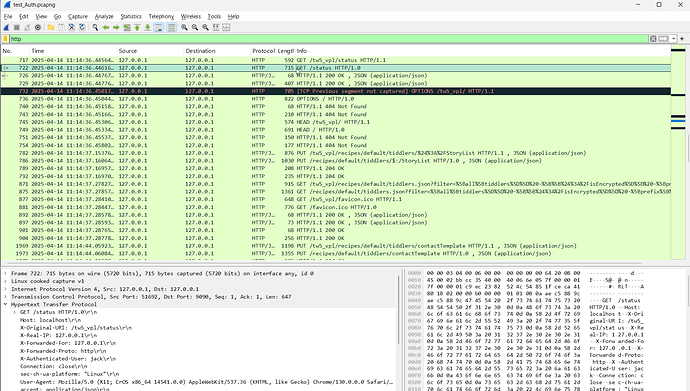Hi Jeremy !
Thanks a lot for your answer.
I’ve conducted additional test that I would like to submit to your attention
My intend, with these tests, is to deploy a authentication server in front of my lovely tw5
Once I have authenticated the user, I want to use nginx (see below my config) to update the X-Authenticated-User header
The idea is to forbit the access to the user if the AuthN server decides it (inactivity of the browser for a
certain amount of time for example like on the banking systems).
The test I’ve done
- tw5 server start command:
node_modules/tiddlywiki/tiddlywiki.js wikis/mynewwiki --listen host=0.0.0.0 port=9090 username=joe authenticated-user-header=X-Authenticated-User
- nginx (see attached) but mainly
-
js_set $authenticated_user main.getAuthenticatedUser; for updating a variable on each request
- proxy_set_header X-Authenticated-User $authenticated_user; for setting the value
I’ve captured the traces (wireshark traces cannot be attached I put a screenshot
nginx is listening on 80
tw5 backend listeing on 9090
What I noticed
- (frame 717) The request is sent from my browser
- (frame 722) The X-Authenticated-User is set to ‘jack’. As my username=joe I expect a 404
- (frame 726 729) Here I get a 200 OK where I should get a 404 … no ?
- (frame 745-754) I have a new request starting from the browser, going through the nginx, reaching tw5 with jack as X-Authenticated-User
Looks nice
- (frame 782-792) Here another session with a PUT /tw5_vpl/… with the same path & ‘jack’ header.
This time I get a 204 … why not a 404
- (frame 871-904) Again a 200 OK where we should get a 404 …?
So I don’t understand why I do not get a 404 all the time ?
I do not understand why, when I get a 404 (frame 745-754) this does not stop the session definitely ?
From a user perspective, it is as if nothing was going wrong when I use the tw5. I can search for, add, delete tiddler…
=====================================================
nginx.conf
load_module modules/ngx_http_js_module.so;
events {}
http {
# Set the path to our njs JavaScript files
js_path “/etc/nginx/njs/”;
# Import our JavaScript file into the variable "main"
js_import main from tw5.js;
log_format custom_format '$remote_addr - $remote_user [$time_local] "$request" '
'$status $body_bytes_sent "$http_referer" '
'"$http_user_agent" "$http_x_backend"';
access_log /var/log/nginx/access.log custom_format;
error_log /var/log/nginx/error.log debug;
server {
js_var $log_level "DEBUG";
listen 80;
js_set $authenticated_user main.getAuthenticatedUser;
# Main access to /tw5_vpl/
location /tw5_vpl/ {
proxy_pass http://127.0.0.1:9090/;
proxy_set_header Host $host; # Forward the original Host header
proxy_set_header X-Original-URI $request_uri; # Forward the original request URI
proxy_set_header X-Real-IP $remote_addr; # Forward the real client IP
proxy_set_header X-Forwarded-For $proxy_add_x_forwarded_for; # Forward the X-Forwarded-For header
proxy_set_header X-Forwarded-Proto $scheme; # Forward the original scheme (http/https)
proxy_set_header X-Authenticated-User $authenticated_user;
proxy_intercept_errors on;
}
}
}
Could you please provide me some guidance on how to stop the session ?
Thanks very much for your help
